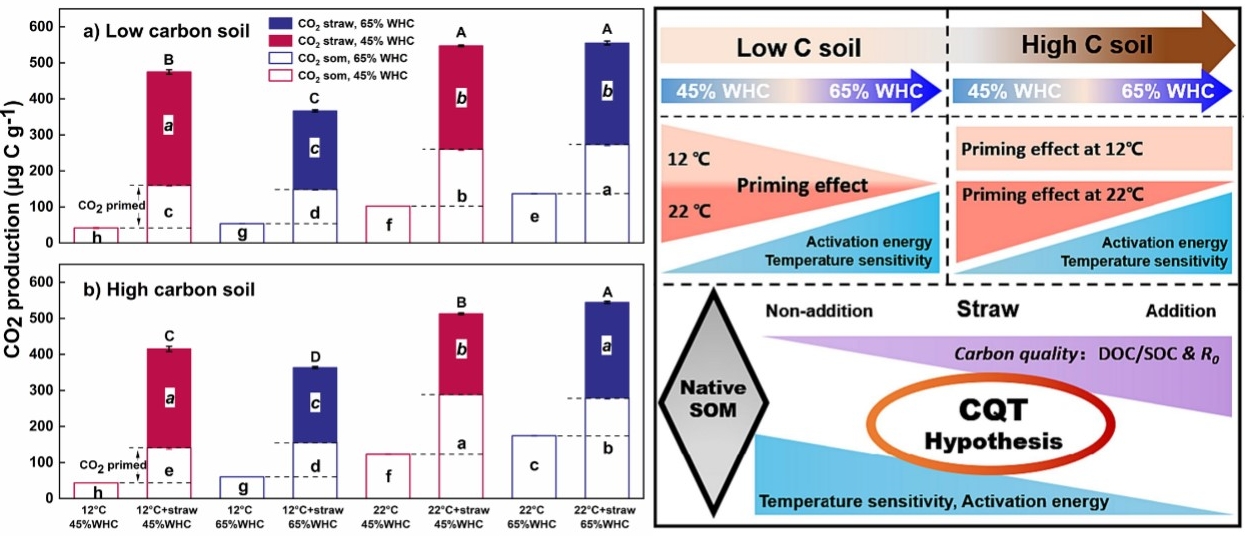Soil organic matter (SOM) is crucial for soil health and carbon storage in agriculture. Adding crop residues to the soil enhances SOM, but may also accelerate its breakdown, known as the priming effect (PE). The temperature sensitivity (Q10) of SOM breakdown is key, affecting how carbon cycling interacts with climate change. SOM breakdown is influenced by factors like microbes, plants, soil moisture, and temperature. Despite extensive research, how multiple factors, especially external organic matter input, affect SOM breakdown remains unclear.
Recently, Prof. Lu-jun Li's team from the Northeast Institute of Geography and Agroecology, Chinese Academy of Sciences (CAS), focused on black soil in northeast agricultural fields. Using microcosm-controlled experiments and 13C stable isotope tracing technology, they conducted an in-depth exploration of the impact of soil temperature (12°C and 22°C) and moisture (45% WHC and 65% WHC), as well as their interaction, on the PE and temperature sensitivity of SOM.
This work was published in Geoderma on Feb. 2.
During the 66-day incubation period, approximately 11% of straw carbon was mineralized into CO2, accounting for 44-67% of total emissions. Soil temperature, moisture, and carbon content, along with their interactions, influenced SOM mineralization. Adding straw significantly increased SOM mineralization and caused a positive priming effect (PE). Due to the inputs of fresh external substances, soil microbes mineralized SOM to obtain nitrogen for growth, supporting the microbial N mining theory. Under 45% WHC and 22°C conditions, low moisture altered microbial growth strategies from r-strategists to K-strategists. This shift accelerated the mineralization rate of SOM, and amplified the PE (Fig. 1).
Furthermore, straw addition significantly decreased the temperature sensitivity of SOM mineralization. The inputs of external substances accelerated SOM decomposition, increasing soil's labile carbon content and enhancing SOM quality, which is a key factor influencing SOM temperature sensitivity. Higher-quality SOM decomposition typically requires lower activation energy (Ea), leading to lower Q10 values (Fig. 1). This finding aligns with the Arrhenius equation and supports the carbon quality-temperature (CQT) hypothesis.
The study also revealed that lower soil moisture reduced the Q10 values (Fig. 1). Reduced moisture restricted solute diffusion in soil water films and microbial activity, indicating that drought conditions could mitigate the temperature sensitivity of SOM mineralization by reducing Q10 values.
These research findings enhance our understanding of how soil C dynamics respond to external organic matter input in the context of climate change.

Figure 1. Conceptual diagram of soil organic matter turnover.
Contact:
Lu-jun Li
Northeast Institute of Geography and Agroecology, Chinese Academy of Sciences
E-mail: lilujun@iga.ac.cn
Reference:
Peng He, Lu-Jun Li*, Shan-Shan Dai, Xiao-Li Guo, Ming Nie, Xuechen Yang*, Yakov Kuzyakov. "Straw addition and low soil moisture decreased temperature sensitivity and activation energy of soil organic matter." Geoderma, 2024, 442, 116802.
https://doi.org/10.1016/j.geoderma.2024.116802

